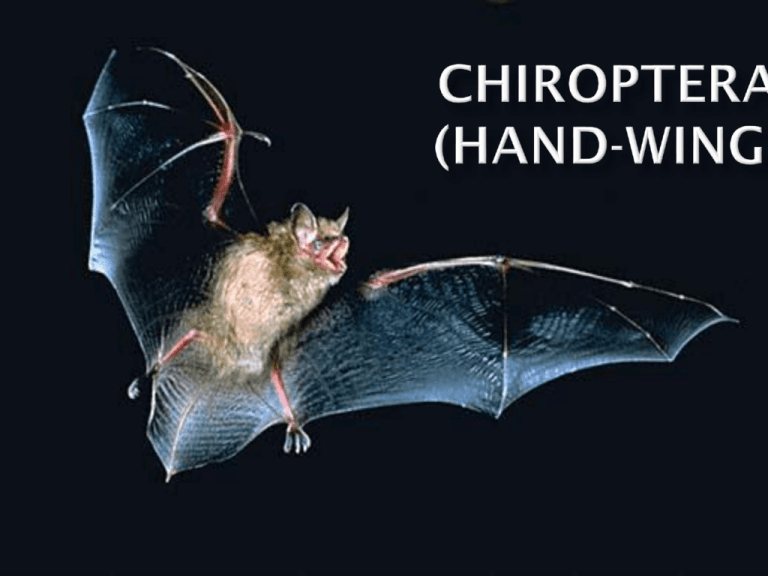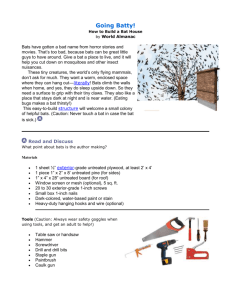Chiroptera week five
advertisement

Bats High speed w/ extreme maneuverability. Can fly up to 60 mph but average about 10 mph Bats forage and eat on the wing. Only true flying mammals Date to Eocene (50 mya) worldwide 17 families 170 genera 957 species suborders Megachiroptera-flying foxes of tropics Microchiroptera-worldwide Modes of Flight: Flight surface is covered with skin and supported by four fingers: What is the fifth finger used for?_______________________ Why is the pelvis so small and the thoracic region so large? ______________________________________________ True echolocation occurs only in the microchiroptera. Sound is produced in the larynx. Sound is emitted through the nose or the open mouth. Echolocation is used for catching prey and flying. http://content.lib.utah.edu/cdm4/item_vi ewer.php?CISOROOT=/wss&CISOPTR=10 01 So how can the bat be removed????? How echolocation works: Animals emit calls, then listen to the echoes that return from various objects. They use these echoes to locate and identify the objects. weird bat boy http://www.youtube.com/watch?v=r9mvRRwu5Gw &safety_mode=true&persist_safety_mode=1&safe =active http://videos.howstuffworks.com/animals/ba ts-videos.htm Why can we hear some of the bat sounds and not others?___________________________. Whispering bats such as the vampire bat we can not hear. Answer: Humans hear sounds ranging up to 20 kHz, while most bats use a broader range (from about 9 kHz to 200+ kHz) Why can we hear some of the bat sounds and not others. Video explanation. Whispering bats such as the vampire bat we can not hear Humans hear sounds ranging up to 20 kHz, while most bats use a broader range (from about 9 kHz to 200+ kHz) http://videos.howstuffworks.com/animals/batsvideos.htm Used primarily by insectivores and piscivores bats why?__________________________________ Molossids Noctilionids Microchiroptera Vespertilionids Some bats emit the pulses through the nose. Rhinolophids. Why use high frequency sounds? High frequency sounds travel rapidly in air. Earliest bat fossils are from the early Eocene of North America: Icaronycteris index There are no intermediate forms - earliest bats are good bats. Why?_______________________ Mosquito 100 mya Bat Fossil 50 mya the all are, ‘evening’ bats all are insectivorous, hence migrate or hibernate 9 species found on Long Island Where do these bats roost?____________________ Just the facts: NY’s most common bat 6-9 grams may live to 25 years favors ponds and streams for foraging forages at about 13 mph, 3-6 m above ground mate in early autumn; fertilization in spring; 50-60 day gestation move to maternity colonies of hundreds born after 30 minute labor in late May weighing1.5 grams reaches sexual maturity at 8 mos. http://www.youtube.com/watch?v=brjYYaZavoQ&safety_mode =true&persist_safety_mode=1 Little Brown Myotis Range Formerly Keen’s Myotis, Myotis keenii Adopt a Bat :) http://video.nationalgeographic.com/video/player/animals/mammalsanimals/bats/bat_woollyfalsevampire_eatsbat.html http://www.youtube.com/watch?v=moG6JDmJdc&safety_mode=true&persist_safety_mode=1&safe=active http://animal.discovery.com/videos/raw-nature-vampire-bats.html Based on the past Video, Vampire bats cause what Illness: __________ Comparisons of Deaths in the U.S. to Bat Rabies: Bat Transmitted Rabies (19802000): 1.2 people per year Accidents Involving Deer: 200 people per year Lightning Strikes: about 90 people per year Dog attacks: 15-25 people per year Toppling Vending Machines: 2.2 people per year (So, more people are killed from toppling vending machines than bat rabies) Still Please Don't Pick Up or Touch Any Bats! Pteropodidae Also called Old World fruit and flying foxes and found only in the tropics. 154 species Predominantly nocturnal Large body sizes ranging from 15g to 1.6Kg. (up to 5 feet and 3-6pounds) They are specialized for feeding on fruit and nectar. (Crush and drink the fruit juice) http://www.youtube.com/watc h?v=uhMXptEj6z8&safety_mode Contrary to popular belief, not all bats can echolocate. Megachiroptera, they do not echolocate like microchiroptera. Large-bodied, and feed on fruit, nectar, and pollen. They rely mainly on vision and olfaction to find food and are often referred to as flying foxes because many have doglike faces. http://www.derm.qld.gov.au/wildlife- ecosystems/wildlife/sounds/black_flying_fo x.mp3 Giant golden-crowned flying fox (Largest Bat, 5 feet) Flying foxes (bats) Fruit bats



